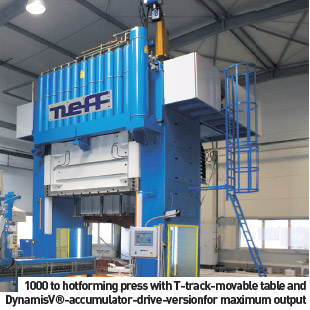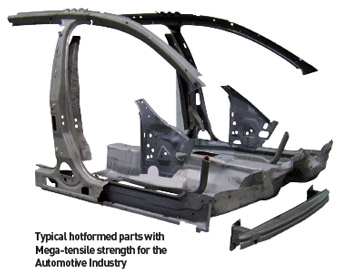Hot stamping technology moves on
High strength-to-weight ratio, high part complexity and high shape accuracy are all benefits of an exciting new manufacturing technology
Weight saving, reduction of CO2 emissions and the improvement of crash safety, these are some of today’s important goals for the automotive industry. An innovative manufacturing technology called hot stamping, can help to meet these goals.
Hot stamping technology is delivering sheet metal auto body structural parts with high strength-to-weight ratio. The technology links the established knowledge of martensitic hardening of special high strength steels with the well-known benefits of deep-drawing processes at higher temperatures. The main benefits of this deformation process are the good plastic formability and the prevention/ avoidance of springback. Thus, components with high strength and high geometrical complexity can be produced with excellent shape accuracy in a single stroke.
Sheet material used with hot stamping technology consists of the boron steel 22MnB5 and is offered by several steel plants using different trade marks: BTR 165 from Benteler; MBW from ThyssenKrupp Steel; ultraform from Voestalpine, and USIBOR 1500P from Arcelor Mittal.
 Chemical analysis of all these products shows similar results: 0.22 per cent - 0.25 percent C; 1.2 per cent-1.4 per cent Mn; 025 per cent-0.35 per cent Si; 0.005 per cent B.
Chemical analysis of all these products shows similar results: 0.22 per cent - 0.25 percent C; 1.2 per cent-1.4 per cent Mn; 025 per cent-0.35 per cent Si; 0.005 per cent B.
Automotive parts produced today by hot-stamping of 22MnB5 sheet material are numerous, for example: A- or B-pillars; front or rear bumper beams; door sills; side-rail parts; tunnels; door beams or roof rails. These types of structural components have ultimate yield stress strength of 1500 MPa to 1700 MPa, elongation of five per cent to nine per cent and thickness of 1.5 mm to 2.5 mm.
Hot stamping technology is a temperature and time dependent process and consists of several steps: heat treatment and austenitisation by continuous- or batch-type furnaces, transfer from the furnace to the press and the deep drawing dies, hot plastic deformation and quenching in closed cool dies.
Each of these steps has to be optimised to get parts with excellent product quality and highly economical process efficiency. On one hand this optimisation requires basic knowledge of the scientific background (that is, heat treating, quenching and plastic deformation of boron steel). It also needs practical experience and expertise in press building and tooling design to meet customers’ demands with regard to hot stamping technology. Neff has 60 years experience of building hydraulic presses, ranging from 2.5 tonnes to 2,500 tonnes.
The first step consists of heating blanks until total austenitisation is achieved. By means of this the ferritic microstructure of blank material at room temperature is transformed to a completely austenitic one. This change of microstructure is time dependent and usually needs a dwell time of four to 10 minutes. Microstructure transformation starts at the lower critical temperature Ac1 and finishes as soon as the upper critical temperature Ac3 is achieved. There exists some well-known empirical equations for estimating the amount of Ac1 and Ac3. By doing this, an Ac1 temperature of about 700°C and an Ac3 temperature of about 800°C is obtained for the boron steel material used. But more precise knowledge of these critical temperatures is dependent on knowing the detailed chemical composition of the steel alloy that is used by the production of the blank material.
Thus, the sheet metal producers must give more detailed information about the exact values of Ac1 and Ac3 and the dwell time.
When using uncoated sheet material, scaling on the surface of the blanks cannot be avoided during transfer from the furnace to deep drawing dies in the press and during plastic deformation in the deep drawing dies, even when a protective atmosphere is used in the furnace. To protect work pieces against scaling a pre-coated sheet material can be applied. In general, the suppliers of 22 MnB5 sheet material offer a coating of aluminium-silicon alloy.
Melting point of this Al-Si protective layer is about 620 °C. But even at temperatures below 620°C, an intermetallic alloying reaction between the Al-Si layer and the iron substrate of the sheet material takes place. Because of this reaction, the Al-Si-layer is, step by step, transformed into an Fe-Al-Si layer. The melting point of this Fe-Al-Si coating is higher than that of the original Al-Si coating.
The rise of the melting point of the coating is dependent on its transforming rate, but takes place continuously and can reach a maximum of 1100 °C. The heat treatment of the blanks in the furnace should not only take into account the kinetics of the change from ferrite into austenite but also the inter-metallic alloying reaction between the Al-Si coating and the iron substrate of the blank. Because the rise of the melting point of the coating is dependent on this intermetallic reaction, a too rapid heating of the blanks can cause the melting and loss of the coating. To prevent this, heating rate should not exceed 12°C per second (°C/s).
In the second step, the austenised hot blanks must be transferred from the heating furnace to the die of the deep drawing press. If this transportation takes place in the open air of press shop temperature, loss of the blanks by air-cooling cannot be avoided. This loss can be as high as several tens of °C /s. It depends on blank thickness. For example, with 1.5mm thickness, the cooling rate of the blanks is approximately 20°C/s and with 2.5mm thickness 12°C/s.
Thus, time needed to carry out blank transportation should to be as short as possible. The target transfer time should be five to seven seconds. This means a blank of thickness 1.5mm loses 140°C during a transfer time of seven seconds.
To get a total austenitic microstructure of blank material that is needed to get complete hardening, a furnace temperature higher than Ac3 and sufficient dwell-time is needed. To compensate for this loss, the temperature of the blanks when taken out of the furnace must be higher than Ac3. By means of this, the blanks have to be heated in the furnace to a temperature of approximately 950°C with an average dwell time of five minutes. This ensures that the temperature of the blank is not lower than 800°C when plastic deformation begins.
During the next step – stamping and hardening – the punch speed should be high enough to limit the heat exchange between work-piece and die during plastic deformation of the blank. Therefore, the time to close the tools completely should not exceed one to two seconds.
Quenching is carried out just after plastic deformation is finished and the tools are closed. During this time, the work piece is rapidly cooled by contact with the surfaces of the die. Martensitic transition takes place between so-called martensitic start temperature MS and so-called martensitic finish temperature Mf. The amount of MS and that of Mf can also be estimated by means of well-known empirical equations. By doing so, an MS temperature of about 390°C and an Mf temperature of about 190°C is obtained for the boron steel material used. But more precise knowledge of these critical temperatures is dependent on the detailed chemical composition of the steel alloy and must be given by the producers of the blank material. To avoid incomplete martensitic microstructure, the stamped part should not be removed from the die before its temperature is lower than Mf. Therefore the work-piece temperature at the exit of the press should be between 150°C to 170°C.
To get a fully martensitic microstructure, the cooling speed must greater than the so-called critical cooling rate. This is 27 °C/s to 30°C/s. Higher rates are desirable, to shorten the time that is needed to produce one work piece. Shorter times are the key to improving the efficiency and productivity of hot stamping technology.
The cooling rate during quenching depends largely on the quantity of thermal energy that is lost by the deformed part and absorbed by the die. The closing time of the die, however, is significantly influenced by the quench and cooling rate. The time that is needed to produce one part by means of the new technology is essentially determined by this closing time. Decreasing this time means increasing the efficiency and productivity of the whole manufacturing process.
Today, by means of optimised die design, quench rates up to 100°C/s can be realised. This means closing time that can be achieved by modern tool design is approximately 15 seconds. The main factor responsible to get higher cooling rates is the die design. Die design for hot stamping technology has to respect two aspects: a perfect plastic deformation by one stroke must be carried out; and quick and sufficient cooling of the deformed work piece must be realised so as to get a perfect martensitic microstructure in the work piece material. To get a sufficient cooling rate, a significant quantity (up to 100 kW) of the thermal energy must be absorbed by the die and then drawn off by efficient cooling devices. Thus, the die designer has to find a compromise between good wear resistance (over a wide range of temperatures) and good thermal conductivity of die material.



